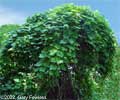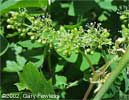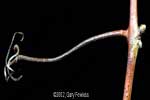
Shrubs of Wisconsin
| Vitis
riparia Michx. frost grape; river bank grape Family: Vitaceae |
||||||||||||||||
|
||||||||||||||||
|
Vitis riparia is the most common wild grape in Wisconsin. Leaves are alternate, simple and lobed (there can be dramatic differences in the lobing pattern from one leaf to the next). The lobes are generally sharp-pointed and there are also large sharp teeth along the margin. The growth form is that of a woody vine. There are well-developed tendrils that wrap around nearby plants or other objects to help the vine climb. Fruits range from medium blue to nearly black and each fruit contains 2-6 ovate, blunt seeds. The fruits of Vitis riparia are roughly similar to those of Menispermum canadense (Canada moonseed). The fruits of Menispermum canadense are reported to be poisonous with potentially fatal consequences. Wild food foragers should be very careful to distinguish between the two, and to refrain from eating wild fruits if they are not absolutely sure of the identification. People who have experienced both species will have no trouble telling them apart, but the following is offered for those who may be unfamiliar with them. Vitis riparia has 2-6 blunt, ovate seeds per fruit and the fruits of Menispermum canadense each contain a single flattened crescent-shaped seed. Compare seeds of the two species. Menispermum leaves may be unlobed or slightly blunt-lobed, and the leaf margins are entire. Leaves of Vitis are sharp lobed with obvious sharp teeth. Menispermum leaves also tend to be more blue green than Vitis. Compare leaves. Vitis riparia usually has tendrils and Menispermum canadense does not.
|
|








